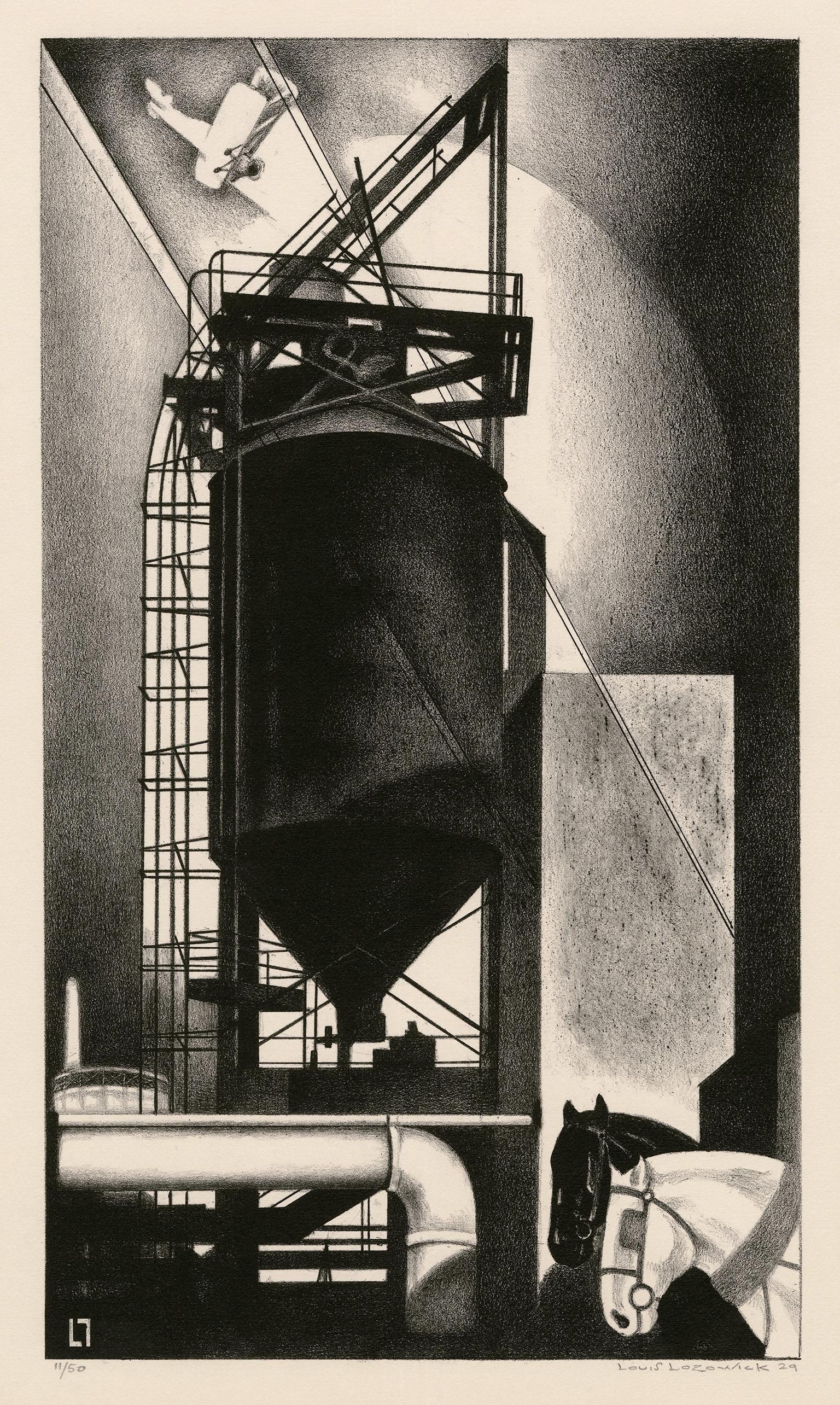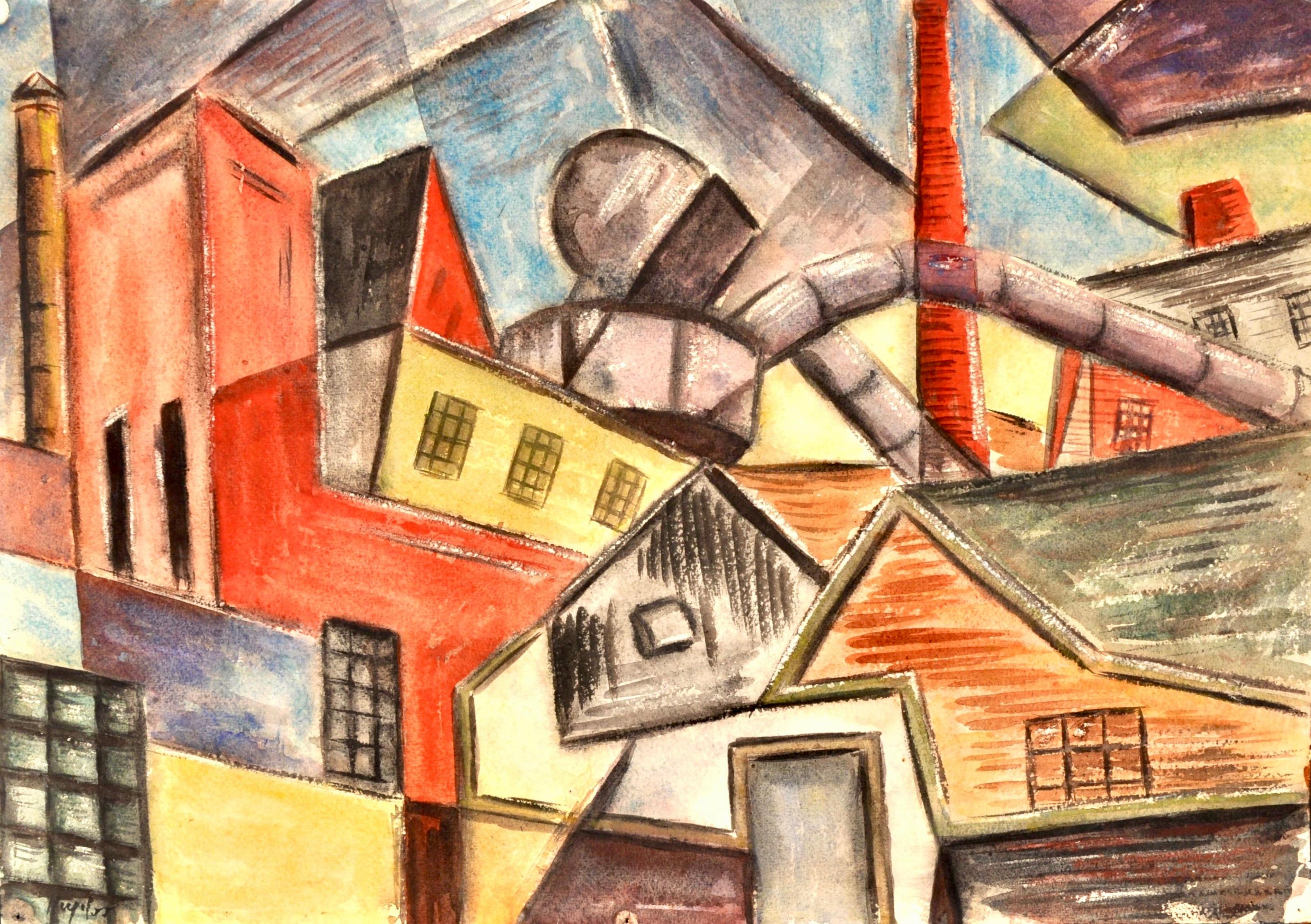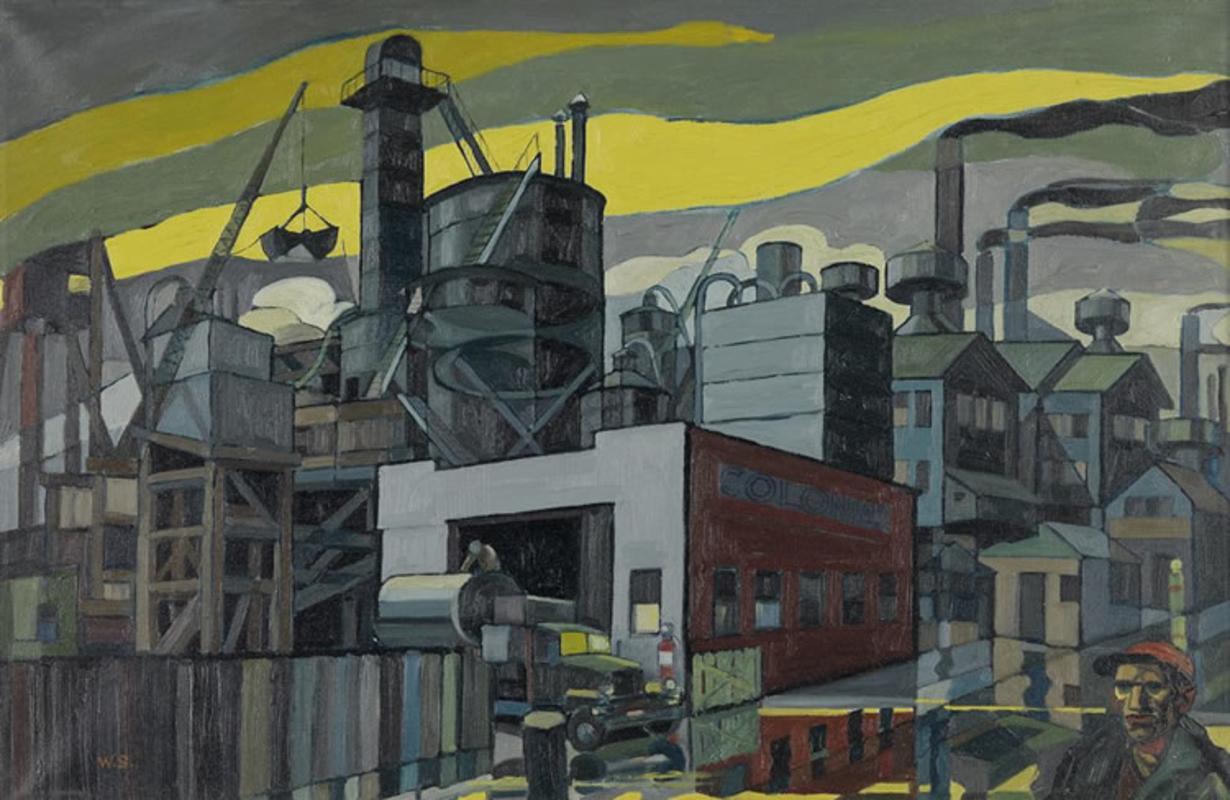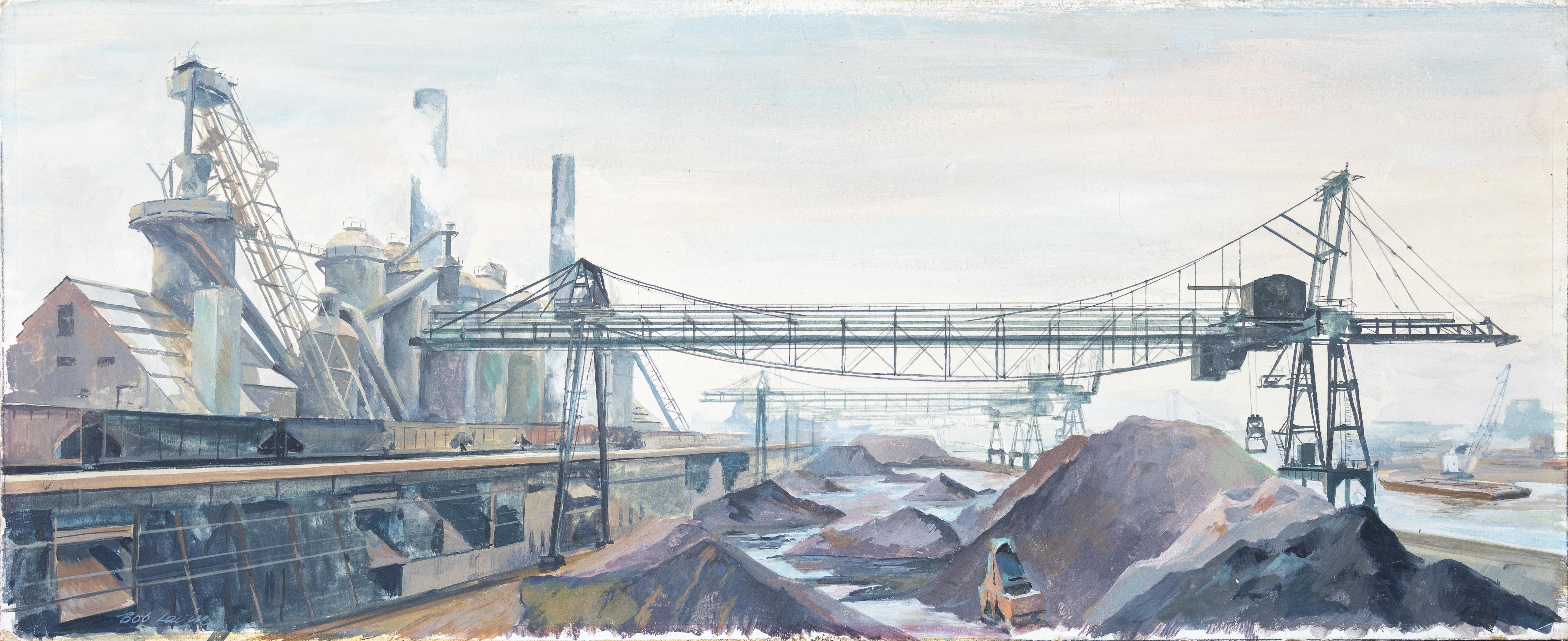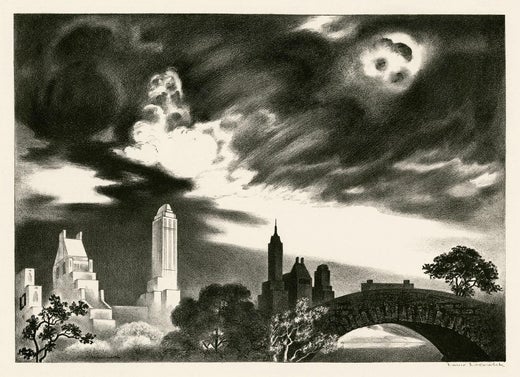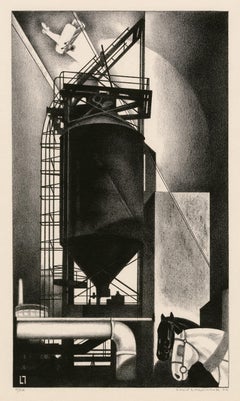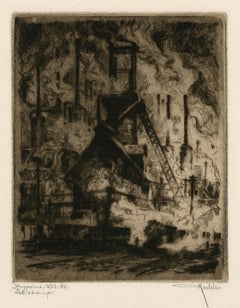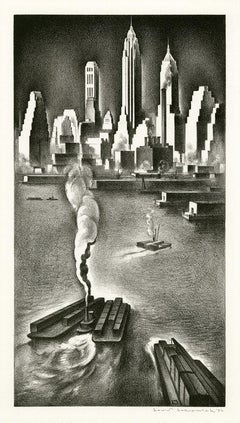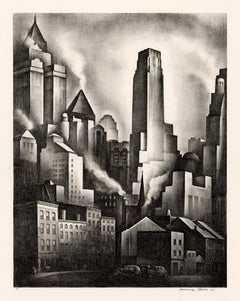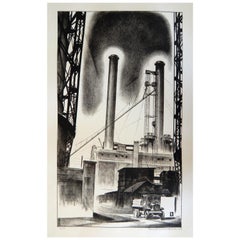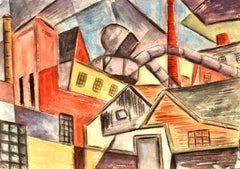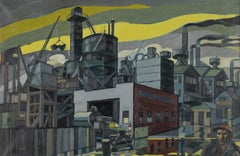Items Similar to 'Corner of Steel Plant' — American Modernism / Precisionism
Want more images or videos?
Request additional images or videos from the seller
1 of 3
Louis Lozowick'Corner of Steel Plant' — American Modernism / Precisionism1929
1929
$2,600
£1,967.64
€2,259.94
CA$3,697.33
A$4,008.66
CHF 2,112.56
MX$48,749.25
NOK 26,283.56
SEK 24,855.44
DKK 16,871.69
About the Item
Louis Lozowick, 'Corner of Steel Plant', lithograph, 1929, edition 25, and 10 printed in 1972; Flint 21. Signed, titled, dated, and numbered 'I/X' in pencil. The artist’s monogram in the stone, lower left. A superb impression, on heavy, off-white wove paper, with full margins (3 to 4 1/2 inches). Barely visible light toning within a previous mat opening; a 1/2-inch wide strip of very pale toning at the top sheet edge; otherwise in excellent condition. An impression from the second edition of 10, printed by Barr Miller in 1972. Archivally matted to museum standards, unframed.
Image size 11 1/2 x 7 13/16 inches (292 x 198 mm); sheet size 20 x 14 1/4 inches (508 x 362 mm).
Impressions of this work are in the following museum collections: Collections: Allentown Art Museum, Brooklyn Museum, Crystal Bridges Museum of American, Grinnell College Museum of Art, Memphis Brooks Museum of Art, National Gallery of Art, Philadelphia Museum of Art, Smithsonian American Art Museum.
ABOUT THE ARTIST
“A beautifully articulated synthesis of strong personal visions and an extraordinary command of black-and-white lithography remained constant. His prints have withstood the inevitable fluctuations of fashion and taste, and today are deservedly appreciated by both connoisseurs and a new generation as among the finest created in twentieth-century America.”
—Janet Flint, 'The Prints of Louis Lozowick: A Catalogue Raisonné', Hudson Hills Press, NY, 1982.
Born in Russia in 1892, Lozowick came to this country at the age of 14 to join his brother in New York City. By 1919 he had attended art school, finished college, served in the army, and traveled throughout the United States, visiting major cities which would later become subjects of his work. From 1919 to 1924, Lozowick lived and traveled throughout Europe, staying in Paris, Berlin, and Moscow. While in Berlin, he became friends with Laszlo Moholy-Nagy, El Lissitsky, and the avant-garde Russian artists affiliated with the November-gruppe. On his return to New York in 1924, he joined the executive board of the New Masses and exhibited his machine age drawings, the ‘Machine Ornament’ series in the 1926 exhibition of Katherine Dreier’s Société Anonyme; three years later, he made his first prints.
Having assimilated European Constructivist and Cubist theories and the Bauhaus manifesto promoting the integration of applied and fine art, Lozowick was inspired to present the rapidly growing New York City skyline with its monumental skyscrapers as modern symbols of optimism. Like many other Depression-era artists, he identified closely with the common worker and valued the consummate craft and workmanship dictated by the printmaking process. His versatility and range of interests were exemplified by his stage sets for the 1926 production of Georg Kaiser’s play “Gas,” the first Constructivist production seen in America. A year later, his images and essay were centerpieces in the pivotal 1927 Machine Age Exposition in New York. Lozowick’s first solo exhibition of lithographs depicting primarily soaring urban cityscapes and industrial scenes was mounted by the renowned Weyhe Gallery in 1929.
Assigned to the WPA New York Graphic Arts Division in 1935, he left in 1936 to accept a commission from the prestigious Treasury Relief Art Project for two large oil paintings for the Post Office at 33rd Street in Manhattan. His preliminary lithographic studies for the paintings are among his most compelling images of New York skyscraper and bridge forms.
Returning to the Project in 1938, Lozowick experimented with various printmaking mediums, including wood engraving, drypoint, and screen printing, until the end of his appointment in 1940. During the next three decades, encouraged by Carl Zigrosser of the Weyhe Gallery, he devoted himself primarily to lithography, mounting several solo exhibitions at major New York galleries and a retrospective at the Whitney Museum of American Art in 1972. Posthumous solo and group exhibitions of Lozowick’s work include the Hirshhorn Museum and Sculpture Garden (2001), de Young Museum (2007), British Museum (2008), National Gallery of Art, Washington D.C. (2015), Whitney Museum of American Art (2015), Brooklyn Museum of Art (2015), and the Palmer Museum of Art (2019).
Louis Lozowick’s graphic works are held in numerous prominent museum collections, including the Amon Carter Museum of American Art, Art Institute of Chicago, Baltimore Museum of Art, Brooklyn Museum, Cornell University Library, Museum of Fine Arts (Boston), Museum of Modern Art, New York Public Library, Philadelphia Museum of Art, Smithsonian American Art Museum, Walker Art Center, and the Whitney Museum of American Art.
- Creator:Louis Lozowick (1892 - 1973, American)
- Creation Year:1929
- Dimensions:Height: 11.5 in (29.21 cm)Width: 7.82 in (19.87 cm)
- Medium:
- Movement & Style:
- Period:
- Condition:
- Gallery Location:Myrtle Beach, SC
- Reference Number:Seller: 1016801stDibs: LU53239999022
Louis Lozowick
Louis Lozowick is widely recognized as a key figure in America's Precisionist movement and a leader in mid-20th-century modernist printmaking. His graphic works and paintings have been acquired by numerous museums including the Art Institute of Chicago, Brooklyn Museum, Crystal Bridges Museum of American Art, Fine Arts Museums of San Francisco, Metropolitan Museum of Art, Museum of Modern Art, New York Public Library, Philadelphia Museum of Art, Smithsonian American Art Museum, U. S. Library of Congress and the Whitney Museum of American Art.
About the Seller
5.0
Recognized Seller
These prestigious sellers are industry leaders and represent the highest echelon for item quality and design.
Platinum Seller
Premium sellers with a 4.7+ rating and 24-hour response times
Established in 1995
1stDibs seller since 2016
322 sales on 1stDibs
Typical response time: 1 hour
Associations
International Fine Print Dealers Association
- ShippingRetrieving quote...Shipping from: Myrtle Beach, SC
- Return Policy
Authenticity Guarantee
In the unlikely event there’s an issue with an item’s authenticity, contact us within 1 year for a full refund. DetailsMoney-Back Guarantee
If your item is not as described, is damaged in transit, or does not arrive, contact us within 7 days for a full refund. Details24-Hour Cancellation
You have a 24-hour grace period in which to reconsider your purchase, with no questions asked.Vetted Professional Sellers
Our world-class sellers must adhere to strict standards for service and quality, maintaining the integrity of our listings.Price-Match Guarantee
If you find that a seller listed the same item for a lower price elsewhere, we’ll match it.Trusted Global Delivery
Our best-in-class carrier network provides specialized shipping options worldwide, including custom delivery.More From This Seller
View All'Tanks #1' — American Precisionism
By Louis Lozowick
Located in Myrtle Beach, SC
Louis Lozowick, 'Tanks #1', lithograph, 1929, edition 50, Flint 39. Signed, titled, and numbered '11/50' in pencil. Signed with the artist's monogram in the stone, lower left. A superb, richly-inked impression, on cream wove paper, the full sheet with margins (3/4 to 1 7/8 inches), in excellent condition. Matted to museum standards.
Image size 13 15/16 x 8 1/16 inches (355 x 204 mm), sheet size 15 3/4 x 11 1/4 inches (400 x 286 mm).
Exhibited: 'The American Scene: Prints from Hopper to Pollock', Stephen Coppel, The British Museum, 2008.
Literature: 'Prints and Their Creators, A World History', Carl Zigrosser, Crown Publishers Inc, 1974; 'American Lithographers...
Category
1920s American Modern Figurative Prints
Materials
Lithograph
'The Furnace' — American Expressionism
By Otto Kuhler
Located in Myrtle Beach, SC
Otto Kuhler, 'The Furnace', drypoint, edition 26, 1924, Kennedy 5. Signed and annotated 'Drypoint. Ltd Ed. Del. et imp.' in pencil. Titled in pencil, in the bottom center sheet edge....
Category
1920s American Modern Figurative Prints
Materials
Drypoint
'Mural Study: Lower Manhattan' — WPA Era Precisionism
By Louis Lozowick
Located in Myrtle Beach, SC
Louis Lozowick, 'Mural Study: Lower Manhattan', lithograph, edition 10 or fewer, 1936. Flint 135. Signed and dated in pencil. Signed in the stone, lower right.
A fine, richly-inked...
Category
1930s American Modern Landscape Prints
Materials
Lithograph
'Financial District', New York City — American Modernism
By Howard Norton Cook
Located in Myrtle Beach, SC
Howard Cook, 'Financial District', lithograph, 1931, edition 75, Duffy 155. A fine, richly-inked impression, on cream wove paper, the full sheet with wide margins (2 3/4 to 5 5/8 inches), in excellent condition. Image size 13 5/16 x 10 3/8 inches (338 x 264 mm); sheet size 23 x 16 inches (584 x 406 mm). Matted to museum standards, unframed.
Literature: 'American Master Prints from the Betty and Douglas Duffy Collection', the Trust for Museum Exhibitions, Washington, D.C., 1987.
Collections: Crystal Bridges Museum of American Art, Library of Congress, Metropolitan Museum of Art, Philadelphia Museum of Art, Smithsonian American Art Museum.
ABOUT THE ARTIST
Howard Norton Cook (1901-1980) was one of the best-known of the second generation of artists who moved to Taos. A native of Massachusetts, he studied at the Art Students League in New York City and at the Woodstock Art Colony. Beginning his association with Taos in 1926, he became a resident of the community in the 1930s. During his career, he received two Guggenheim Fellowships and was elected an Academician in the National Academy of Design. He earned a national reputation as a painter, muralist, and printmaker.
Cook’s work in the print mediums received acclaim early in his career with one-person exhibitions at the Denver Art Museum (1927) and the Museum of New Mexico (1928). He received numerous honors and awards over the years, including selection in best-of-the-year exhibitions sponsored by the American Institute of Graphics Arts, the Brooklyn Museum, the Society of American Etchers, and the Philadelphia Print Club. His first Guggenheim Fellowship took him to Taxco, Mexico in 1932 and 1933; his second in the following year enabled him to travel through the American South and Southwest.
Cook painted murals for the Public Works of Art Project in 1933 and the Treasury Departments Art Program in 1935. The latter project, completed in Pittsburgh, received a Gold Medal from the Architectural League of New York. One of his most acclaimed commissions was a mural in the San Antonio Post Office in 1937.
He and Barbara Latham settled in Talpa, south of Taos, in 1938 and remained there for over three decades. Cook volunteered in World War II as an Artist War Correspondent for the US Navy, where he was deployed in the Pacific. In 1943 he was appointed Leader of a War Art Unit...
Category
1930s American Modern Figurative Prints
Materials
Lithograph
'Pipe and Brawn' — WPA Era American Realism
By James Allen
Located in Myrtle Beach, SC
James Allen, 'Pipe and Brawn,' 1937, lithograph, edition 40. Signed and annotated 'Ed/40' in pencil. A superb, richly inked impression on cream wove paper, the full sheet with margin...
Category
1930s American Realist Figurative Prints
Materials
Lithograph
'George Washington Bridge (Under Construction)' — 1920s New York City
By Otto Kuhler
Located in Myrtle Beach, SC
Otto Kuhler, 'George Washington Bridge' (under construction) also titled 'The Cables That Hold it All', etching, 1928, edition unknown. An uns...
Category
1920s American Modern Figurative Prints
Materials
Etching
You May Also Like
Louis Lozowick Original Lithograph, 1929, "Edison Plant"
By Louis Lozowick
Located in Phoenix, AZ
Original lithograph in excellent condition by Louis Lozowick (1892-1973).
Pencil signed lower right. Edition size lower left.
No. 24 in the Raisonne by Janet Flint. Edition of 20.
Th...
Category
Early 20th Century Modern Abstract Prints
Materials
Paper
"Cubist Factory" American Scene WPA Social Realism Mid 20th Century Industrial
Located in New York, NY
"Cubist Factory" American Scene WPA Era Social Realism Mid 20th Century Industrial
Herbert Heyel (American 1907-2000)
"Cubist Factory"
14 x 20 inches
Watercolor on paper, c. 1933
S...
Category
1930s American Realist Landscape Drawings and Watercolors
Materials
Paper, Watercolor
"Colonial Sand and Stone Company, New York, " Industrial WPA Scene, Precisionist
By William Sharp
Located in New York, NY
William Sharp (1900 - 1961)
Factory on the River
Oil on canvas
20 1/2 x 28 1/2 inches
Initialed lower left: WS
Provenance:
Estate of the artist
Private Collection, New York
Swann Auction Galleries, American Art, June 13, 2019, Lot 178
Private Collection, New York
Colonial Sand and Stone Co., founded by Generoso Pope, was once the country’s largest sand and gravel business, providing the concrete for much of New York City’s skyline, including the Empire State Building, Rockefeller Center, Radio City Music Hall, airports and subways.
William Sharp was born on June 13, 1900, in Lemberg, Austria, where he attended college and the Academy for Arts and Industry. He later studied in Kraków, Poland, and in Berlin and Munich, Germany. Sharp began his career as a designer of stained-glass windows and as a painter of murals. He served in the German army during World War I. After the war he became a newspaper artist in Berlin and a well-known etcher.
Sharp drew political cartoons that were bitterly critical of the growing Nazi movement. As the influence of National Socialism intensified, he began to contribute drawings, under a pseudonym, to publications that were hostile to Hitler. After Hitler assumed power, Sharp was confronted with these drawings and told that he would be sent to a concentration camp. However, in 1934, he escaped to the United States.
His first newspaper assignment in America was making courtroom sketches for The New York Mirror...
Category
Mid-20th Century American Realist Landscape Paintings
Materials
Canvas, Paint, Oil
"Shipyard" Realist Industrial Landscape
By Robert Lavin
Located in Austin, TX
This painting is a 20th century realist landscape depiction of a shipyard by Robert Lavin. The piece is executed in oil on board and measures 10" x 24".
Robert Lavin was born in New York City. His education included Townsend Harris, a prep school in New York followed by college at City College of New York. He also attended the National Academy of Art, where he studied as a painter. Studying the social realists of the 1930’s, Lavin, a former Marine pilot, portrayed steelworkers, roughnecks and trainmen. Lavin often painted his “proletarian ballets”- as one critic called them – to illustrate magazine advertisements.
The Smithsonian Institution and other museums collected Lavin’s original paintings, which portrayed the laboring subjects with dignity and integrity. Lavin also illustrated stock certificates and books. Paper Money magazine praised him as “one of the greatest vignette artists of the 20th century.” In addition to this, Lavin was for a number of years an Associate Professor of Art at City College of New York, a position he left in the mid ‘60’s in order to devote himself full time to his painting. His commissions took him around the world, from the North Sea to the coast of Africa, from the slopes of Alaska to the Sea of Japan. As part of a series for Gulf Oil, he painted the royal family of England for the opening of a new refinery in Wales. Another portrait of one of the early Americanastronauts, appeared on the cover of Time Magazine. Other major commissions during these years included Readers Digest books...
Category
20th Century American Realist Landscape Paintings
Materials
Oil, Board
Price Upon Request
The Concrete Plant
By Arnold A. Grossman
Located in San Francisco, CA
Artist: Arnold Grossman (American, 1923-2016)
Title: The concrete Plant
Year: c.1970
Medium: Watercolor
Paper: Watercolor paper
Image size: 11.25 x...
Category
Late 20th Century American Impressionist Landscape Drawings and Watercolors
Materials
Watercolor
WPA Era, Industrial Scene of a Steel Mill by Artist Harold Haydon
By Harold Haydon
Located in Chicago, IL
A ca. 1935 tonal, watercolor of a steel mill by artist Harold Haydon. Artwork size: 8 3/4" x 11 3/4". Archivally matted to 14" x 18". Provenance: Estate of the artist.
Harold E...
Category
1930s American Modern Abstract Drawings and Watercolors
Materials
Watercolor, Paper
$585 Sale Price
31% Off
